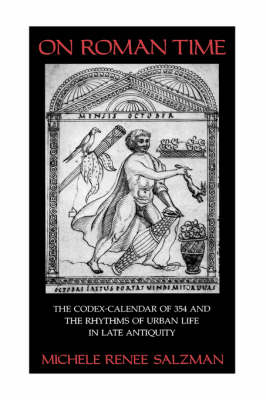
On Roman Time
The Codex-Calendar of 354 and the Rhythms of Urban Life in Late Antiquity
Seiten
1991
University of California Press (Verlag)
978-0-520-06566-6 (ISBN)
University of California Press (Verlag)
978-0-520-06566-6 (ISBN)
Establishes that the traditions of Roman art and literature were still very much alive in the mid-fourth century. This title reveals the importance of pagan festivals and cults in the Christian era and highlights the rise of a respectable aristocratic Christianity that combined pagan and Christian practices.
Because they list all the public holidays and pagan festivals of the age, calendars provide unique insights into the culture and everyday life of ancient Rome. "The Codex-Calendar of 354" miraculously survived the Fall of Rome. Although it was subsequently lost, the copies made in the Renaissance remain invaluable documents of Roman society and religion in the years between Constantine's conversion and the fall of the Western Empire. In this richly illustrated book, Michele Renee Salzman establishes that the traditions of Roman art and literature were still very much alive in the mid-fourth century. Going beyond this analysis of precedents and genre, Salzman also studies "The Calendar of 354" as a reflection of the world that produced and used it. Her work reveals the continuing importance of pagan festivals and cults in the Christian era and highlights the rise of a respectable aristocratic Christianity that combined pagan and Christian practices. Salzman stresses the key role of the Christian emperors and imperial institutions in supporting pagan rituals.
Such policies of accomodation and assimilation resulted in a gradual and relatively peaceful transformation of Rome from a pagan to a Christian capital.
Because they list all the public holidays and pagan festivals of the age, calendars provide unique insights into the culture and everyday life of ancient Rome. "The Codex-Calendar of 354" miraculously survived the Fall of Rome. Although it was subsequently lost, the copies made in the Renaissance remain invaluable documents of Roman society and religion in the years between Constantine's conversion and the fall of the Western Empire. In this richly illustrated book, Michele Renee Salzman establishes that the traditions of Roman art and literature were still very much alive in the mid-fourth century. Going beyond this analysis of precedents and genre, Salzman also studies "The Calendar of 354" as a reflection of the world that produced and used it. Her work reveals the continuing importance of pagan festivals and cults in the Christian era and highlights the rise of a respectable aristocratic Christianity that combined pagan and Christian practices. Salzman stresses the key role of the Christian emperors and imperial institutions in supporting pagan rituals.
Such policies of accomodation and assimilation resulted in a gradual and relatively peaceful transformation of Rome from a pagan to a Christian capital.
Michele Renee Salzman is Associate Professor of History at University of California, Riverside.
| Erscheint lt. Verlag | 1.7.1992 |
|---|---|
| Reihe/Serie | Transformation of the Classical Heritage ; 17 |
| Verlagsort | Berkerley |
| Sprache | englisch |
| Gewicht | 816 g |
| Themenwelt | Geschichte ► Hilfswissenschaften ► Chronologie |
| Naturwissenschaften ► Physik / Astronomie ► Astronomie / Astrophysik | |
| ISBN-10 | 0-520-06566-2 / 0520065662 |
| ISBN-13 | 978-0-520-06566-6 / 9780520065666 |
| Zustand | Neuware |
| Haben Sie eine Frage zum Produkt? |
Mehr entdecken
aus dem Bereich
aus dem Bereich
Buch | Hardcover (2024)
John Wiley & Sons Inc (Verlag)
CHF 198,90
In 3 Volumes
Buch | Hardcover (2023)
World Scientific Europe Ltd (Verlag)
CHF 589,95


